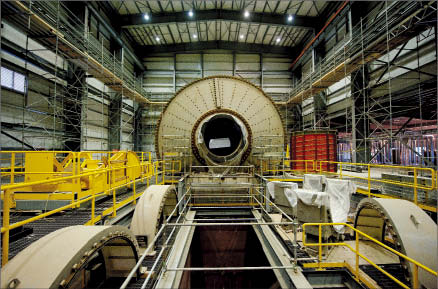New Gold‘s (NGD-T, NGD-X) third-quarter results are in, and they show the company shaping itself into a significant mid-tier gold producer.
Increased gold sales from three operating mines and higher realized gold prices helped boost margins to over US$1,000 per oz. The increase doubled cash flows to $71 million when compared to the same period last year.
But production wasn’t foremost for Randall Oliphant, New Gold’s chairman, during a conference call. Instead, he trumpeted the company’s three development projects as the keys to driving future market-cap growth. Oliphant pointed out that management’s location during the call in Kamloops, B.C., was chosen for its proximity to two of these projects: Blackwater and New Afton.
The third key project is El Morro in Chile, which is held 30% by New Gold and 70% by Goldcorp (G-T, GG-N).
Of the three, New Afton is the closest to contributing to the company’s bottom line. The underground caving process is already underway, with test ore being milled at the site. Oliphant expects cash flows from the mine in eight months.
When it achieves commercial production, the mine is expected to turn out 85,000 oz. gold per year over a 12-year mine life. This is enough gold for a 20% boost to its companywide production, which stands at 400,000 oz. per year.
After that, growth will come from El Morro and Blackwater, two mines that should be contributing enough gold ounces by late 2016 to bring total production up to 1 million oz. per year.
And while Goldcorp drives the development of El Morro, New Gold is firmly in the saddle at the recently acquired Blackwater.
The company gained the project in June through its acquisition of Richfield Ventures. Three months later it released an update that increased the resource by 50%. The project’s indicated resources are now 165 million tonnes grading 1.01 grams gold for 5.4 million oz., while inferred resources stand at 39 million tonnes grading 0.94 gram gold for 1.2 million oz.
The robust results encouraged three more transactions on the property, which will take its interest in the project up to 100% and increase its land position in the area.
Importantly, New Gold won’t be going to the market any time soon to fund its ambitious development plans.
“All of this organic growth remains fully funded,” Oliphant said.
While New Gold’s pipeline looks promising, the company has issues to contend with at its producing mines.
At Cerro San Pedro, shortages at the local cyanide supplier meant that New Gold was left with smaller-than-required cyanide shipments, and that hit production, especially on the silver side. New Gold produced 50% of its targeted silver production levels.
Bob Gallagher, New Gold’s president and chief executive, said the lost silver production would have generated enough credits to bring the mine’s gold production costs down to zero.
He added that since late September, the mine has been getting its full cyanide allotment, and the silver that wasn’t recovered remains on leach pads for extraction at a later date.
But more significant to the company’s bottom line were higher costs at its Peak mines in New South Wales, Australia.
The Australian dollar’s appreciation added US$200 per oz. to costs, while inflation in Australia added US$200 per oz.
Compounding the problem was the poor timing of copper concentrate sales, which missed the US$4-per-lb. copper prices and instead settled for US$3.39 per lb.
If the company cashed in on the US$4 per lb. price that prevailed throughout the quarter, it would have offset the currency and inflation costs.
Gallagher says that while the company is on track to meet the year’s 400,000-oz. production target, it anticipates costs reaching above guidance.
Despite higher costs, Oliphant stressed that New Gold remains one of the lowest-cost gold producers and continues to deliver expanding margins.
It is a contention that the market appears to accept. The company’s shares have climbed close to 60% since January, and traded for $12.54 on Nov. 4.


Be the first to comment on "New Gold on track to produce 1M oz. a year"